International Journal of Information Technology and Computer Science @ijitcs
Статьи журнала - International Journal of Information Technology and Computer Science
Все статьи: 1254

Improving Energy Efficient Clustering Method for Wireless Sensor Network
Статья научная
Wireless sensor networks have recently emerged as important computing platform. These sensors are power-limited and have limited computing resources. Therefore the sensor energy has to be managed wisely in order to maximize the lifetime of the network. Simply speaking, LEACH requires the knowledge of energy for every node in the network topology used. In LEACHs threshold which selects the cluster head is fixed so this protocol does not consider network topology environments. We proposed IELP algorithm, which selects cluster heads using different thresholds. New cluster head selection probability consists of the initial energy and the number of neighbor nodes. On rotation basis, a head-set member receives data from the neighboring nodes and transmits the aggregated results to the distant base station. For a given number of data collecting sensor nodes, the number of control and management nodes can be systematically adjusted to reduce the energy consumption, which increases the network life. The simulation results show that the performance of IELP has an improvement of 39% over LEACH and 20% over SEP in the area of 100m*100m for m=0.1, α =2 where advanced nodes (m) and the additional energy factor between advanced and normal nodes (α).
Бесплатно
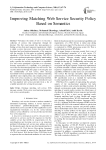
Improving Matching Web Service Security Policy Based on Semantics
Статья научная
Nowadays the trends of web is to become a collection of services that interoperate through the Internet. The first step towards this inter-operation is finding services that meet requester requirements; which is called a service discovery. Service discovery matches functional and non-functional properties of the requester with the provider. In this paper, an enhanced matching algorithm of Web Service Security Policy (WS-SP) is proposed to perform requirement-capability matchmaking of a consumer and a provider. Web service security policy specifies the security requirements or capabilities of a web service participant (a provider or a consumer). Security requirement or a capability of a participant is one of the non-functional properties of a web service. The security addressed through this paper is the integrity and the confidentiality of web service SOA message transmitted between participants. The enhanced matching algorithm states simple policy and complex policy cases of the web service security as a non-functional attribute. A generalization matching algorithm is introduced to get the best-matched web service provider from a list of available providers for serving the consumer.
Бесплатно
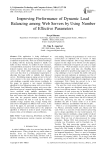
Статья научная
Web application is being challenged to develop methods and techniques for large data processing at optimum response time. There are technical challenges in dealing with the increasing demand to handle vast traffic on these websites. As number of users' increases, several problems are faced by web servers like bottleneck, delayed response time, load balancing and density of services. The whole traffic cannot reside on a single server and thus there is a fundamental requirement of allocating this huge traffic on multiple load balanced servers. Distributing requests among servers in the web server clusters is the most important means to address such challenge, especially under intense workloads. In this paper, we propose a new request distribution algorithm for load balancing among web server clusters. The Dynamic Load Balancing among web servers take place based on user's request and dynamically estimating server workload using multiple parameters like processing and memory requirement, expected execution time and various time intervals. Our simulation results show that, the proposed method dynamically and efficiently balance the load to scale up the services, calculate average response time, average waiting time and server's throughput on different web servers. At the end of the paper, we presented an experimentation of running proposed system which proves the proposed algorithm is efficient in terms of speed of processing, response time, server utilization and cost efficiency.
Бесплатно
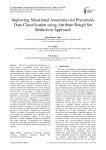
Статья научная
The task of modeling the distribution of a large number of earthquake events with frequent tremors detected prior to a main shock presents us unique challenges to model a robust classifier tool for rapid responses are needed in order to address victims. We have designed using a relational database for running a geophysical modeling application after connecting database record of all clusters of foreshock events from (1998-2010) for a complete catalog of seismicity analysis for the Himalayan basin. by Nath et al,2010. This paper develops a reduced rough set analysis method and implements this novel structure and reasoning process for foreshock cluster forecasting. In this study, we developed a reusable information technology infrastructure, called Efficient Machine Readable for Emergency Text Selection(EMRETS). The association and importance of precursory information in reference to earthquake rupture analysis is found out through attribute reduction based on rough set analysis. Secondly, find the importance of attributes through information entropy is a novel approach for high dimensional complex polynomial problems pre-dominant in geo-physical research and prospecting. Thirdly, we discuss the reducible indiscernible matrix and decision rule generation for a particular set of geographical co-ordinates leading to the spatial discovery of future earthquake having prior foreshock. This paper proposes a framework for extracting, classifying, analyzing, and presenting semi-structured catalog data sources through feature representation and selection.
Бесплатно
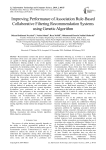
Статья научная
Recommender systems that possess adequate information about users and analyze their information, are capable of offering appropriate items to customers. Collaborative filtering method is one of the popular recommender system approaches that produces the best suggestions by identifying similar users or items based on their previous transactions. The low accuracy of suggestions is one of the major concerns in the collaborative filtering method. Several methods have been introduced to enhance the accuracy of this method through the discovering association rules and using evolutionary algorithms such as particle swarm optimization. However, their runtime performance does not satisfy this need, thus this article proposes an efficient method of producing cred associations rules with higher performances based on a genetic algorithm. Evaluations were performed on the data set of MovieLens. The parameters of the assessment are: run time, the average of quality rules, recall, precision, accuracy and F1-measurement. The experimental evaluation of a system based on our algorithm outperforms show than the performance of the multi-objective particle swarm optimization association rule mining algorithm, finally runtime has dropped by around 10%.
Бесплатно
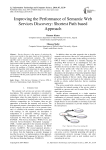
Improving the Performance of Semantic Web Services Discovery: Shortest Path based Approach
Статья научная
Service discovery is the process of retrieving the service most similar to the query based on the description of functional and/or non-functional semantics. The original algorithm used in literature was proposed by Paolucci et al., 2002. Some research works, propose an extension or an improvement of this algorithm to correct the matchmaking used. In this paper we present an algorithm of matchmaking that resolves the problems of Paolucci algorithm by using the shortest path algorithm which determines the optimal matching between user query and provider service. This approach is validated within a framework proposed at the end of this paper and compared with the greedy approach and the bipartite graph based matching..
Бесплатно
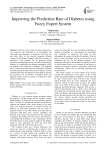
Improving the Prediction Rate of Diabetes using Fuzzy Expert System
Статья научная
The use of fuzzy logic in disease diagnosis is very common and beneficial as it incorporates the knowledge and experience of physician into fuzzy sets and rules. Most of the research proposed different systems for the diabetes diagnosis. But their accuracy of prediction is not accurate. So, the proposed system presents promising approach for accurately predicting the diabetes by considering the different parameters which are helpful in the diagnosis of diabetes. The proposed fuzzy verdict mechanism takes the information collected from the patients as inputs in the form of datasets. System considers both rules and physicians knowledge to provide the prediction rate of diabetes. Evaluation shows the approach results in better accuracy as compared to other prediction approaches.
Бесплатно
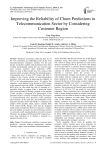
Статья научная
Prediction of customer churn has been one of the most interesting and challenging tasks facing most telecommunication companies recently. For the past decade, researchers together with practitioners have been working and designing models that can correctly make more accurate customer churn predictions (CCP). However, most of these models have less accuracy than expected which is hugely affecting the intended purpose. Consequently, most of these CCP models add little or nothing to the revenue growth of telecommunication industries. This work aims at improving the reliability of CCP in the telecommunication sector. To achieve this objective, a new attribute to be factored in CCP, known as the regional churn rate (RCR), is presented. Basically, RCR gives an idea about the rate of churning in a particular locality or region. Thus, a prediction model with a more accurate CCP using a support vector machine (SVM) classifier is proposed. The performance of the proposed model is critically evaluated using five metrics i.e. misclassification error, precision, recall, specificity and f-measure. At the same time, the performance of the proposed classifier (CCP with RCR) is compared with another SVM classifier which doesn’t consider RCR (CCP without RCR). Results show that the proposed model which considers the RCR of a customer’s location gives the highest accuracies for four performance metrics i.e. precision, recall, misclassification error and f-measure. Therefore, the proposed SVM-based CCP model gives a more clear indication as to whether a customer is a potential churner or not.
Бесплатно
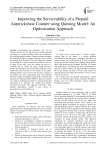
Статья научная
Overcharging the passengers who are not familiar with the city for the services in railway stations and airport is a serious problem which can be addressed by installing prepaid counters. Prepaid counters encounter the problem of higher passenger frequency due to which the waiting time increases. The only alternative solution to this problem is queue formation for effective service. In most of the cases, only one counter for service is available due to which the queue length increases; thereby the passengers may lose patience and move away which may lead to the loss to the counter. In this paper, queuing model is used to solve this real case scenario in an optimal way. The experimental data were obtained from the counter and derived using Little’s Theorem and Single Server Queuing Model (M/M/1). Hence an attempt was made in studying the benefits of queuing model and optimizing it to minimize the waiting time thereby increasing the profit. This approach will help a busy prepaid autorickshaw counter to give service to passengers in a most feasible way.
Бесплатно
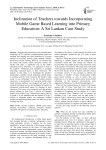
Статья научная
Incorporating information and communication technology (ICT), especially computer/mobile games into teaching and learning has been identified as a proven method of increasing primary grade students’ intrinsic motivation towards learning. However, in countries like Sri Lanka with teacher centric education cultures, the teacher still plays a significant role in the child’s education process. Therefore, it is imperative to look at the teachers’ willingness and inclination to integrate technology enhanced games in their classrooms. The purpose of this study is to investigate the teachers’ preparedness, attitude towards integrating mobile games in teaching and the issues faced by the teachers when trying to use technology in the Sri Lankan primary classroom. A questionnaire for assessing mobile game based learning readiness was designed and used as the research instrument to assess the inclination of teachers to incorporate mobile-based games for learning in their classroom. The survey was conducted involving primary school teachers in four Type 3 schools of Gampaha district in Sri Lanka. Type 3 schools have classes only up to grade 8. It was identified that the teachers in Type 3 schools of Gampaha district are moderately inclined towards incorporating mobile games into their day-to-day teaching activities.
Бесплатно

Статья научная
The usefulness of Collaborative filtering recommender system is affected by its ability to capture users' preference changes on the recommended items during recommendation process. This makes it easy for the system to satisfy users' interest over time providing good and quality recommendations. The Existing system studied fails to solicit for user inputs on the recommended items and it is also unable to incorporate users' preference changes with time which lead to poor quality recommendations. In this work, an Enhanced Movie Recommender system that recommends movies to users is presented to improve the quality of recommendations. The system solicits for users' inputs to create a user profiles. It then incorporates a set of new features (such as age and genre) to be able to predict user's preference changes with time. This enabled it to recommend movies to the users based on users new preferences. The experimental study conducted on Netflix and Movielens datasets demonstrated that, compared to the existing work, the proposed work improved the recommendation results to the users based on the values of Precision and RMSE obtained in this study which in turn returns good recommendations to the users.
Бесплатно
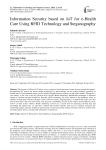
Information Security based on IoT for e-Health Care Using RFID Technology and Steganography
Статья научная
The Internet of Things (IoT) allows you to connect a broad spectrum of smart devices through the Internet. Incorporating IoT sensors for remote health monitoring is a game-changer for the medical industry, especially in limited spaces. Environmental sensors can be installed in small rooms to monitor an individual's health. Through low-cost sensors, as the core of the IoT physical layer, the RF (Radio Frequency) identification technique is advanced enough to facilitate personal healthcare. Recently, RFID technology has been utilized in the healthcare sector to enhance accurate data collection through various software systems. Steganography is a method that makes user data more secure than it has ever been before. The necessity of upholding secrecy in the widely used healthcare system will be covered in this solution. Health monitoring sensors are a crucial tool for analyzing real-time data and developing the medical box, an innovative solution that provides patients with access to medical assistance. By monitoring patients remotely, healthcare professionals can provide prompt medical attention whenever needed while ensuring patients' privacy and personal information are protected.
Бесплатно
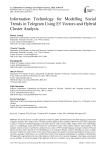
Статья научная
The article presents a modern approach to analysing public opinion based on Ukrainian-language content from Telegram channels. This study presents a hybrid clustering approach that combines DBSCAN and K-means algorithms to analyse vectorised Ukrainian-language social media posts in order to detect public opinion trends. The methodology relies on a multilingual neural network–based text vectorisation model, which enables effective representation of the semantic content of posts. Experiments conducted on a corpus of 90 Ukrainian-language messages (collected between March and May 2025) allowed for the identification of six principal thematic clusters reflecting key areas of public discourse. Despite the small volume of the corpus (90 messages), the sample is structured and balanced by topic (news, vacancies, gaming), which allows you to test the effectiveness of the proposed methodology in conditions of limited data. This approach is appropriate in the case of the analysis of short texts in low-resource languages, where large-scale corpora are not available. A special advantage of this approach is the use of semantic vector representation and the construction of graphs of lexical co-occurrence networks (term co-occurrence networks), which demonstrate a stable topological structure even with small amounts of data. It allows you to identify latent topic patterns and coherent clusters that have the potential to scale to broader corpora. The authors acknowledge the limitations associated with sample size, but emphasise the role of this study as a pilot stage for the development of a universal, linguistically adaptive method for analysing public discourse. In the future, it is planned to expand the body to increase the representativeness and accuracy of the conclusions. The paper proposes a hybrid method of automatic thematic cluster analysis of short texts in social media, in particular Telegram. Vectorisation of Ukrainian-language messages is implemented using the transformer model multilingual-e5-large-instruct. A combination of HDBSCAN and K-means algorithms was used to detect clusters. More than 36,000 messages from three Telegram channels (news, games, vacancies) were analysed, and six main thematic clusters were identified. To identify thematic trends, a hybrid clustering approach was used, in which the HDBSCAN algorithm was used at the first stage to identify dense clusters and identify "noise" points, after which K-means were used to reclassify residual ("noise") embeddings to the nearest cluster centres. Such a two-tier strategy allows you to combine the advantages of flexible allocation of free-form clusters from HDBSCAN and stable classification of less pronounced groups through K-means. It is especially effective when working with fragmented short texts of social networks. To validate the quality of clustering, both visualisation tools (PCA, t-SNE, word clouds) and quantitative metrics were used: Silhouette Score (0.41) and Davis-Boldin index (0.78), which indicate moderate coherence and resolution of clusters. Separately, the high level of "noise" in HDBSCAN (34.2%) was analysed, which may be due to the specifics of short texts, model parameters, or stylistic fragmentation of Telegram messages. The results obtained show the effectiveness of combining modern vectorisation models with flexible clustering methods to identify structured topics in fragmented Ukrainian-language content of social networks. The proposed approach has the potential to further expand to other sources, types of discourse, and tasks of digital sociology. As a result of processing 90 messages received from three different channels (news, gaming content, and vacancies), six main thematic clusters were identified. The largest share is occupied by clusters related to employment (28.2%) and security-patriotic topics (24.7%). The average level of "noise" after the initial HDBSCAN clustering was 34.2%. Additional analysis revealed that post lengths varied significantly, ranging from short announcements (average of 10 words) to analytical texts (over 140 words). Visualisations (timelines, PCA, t-SNE, word clouds, term co-occurrence graphs) confirm the thematic coherence of clusters and reveal changes in thematic priorities over time. The proposed system is an effective tool for detecting information trends in the environment of short, fragmented texts and can be used to monitor public sentiment in low-resource languages.
Бесплатно
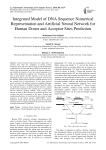
Статья научная
Human Genome Project has led to a huge inflow of genomic data. After the completion of human genome sequencing, more and more effort is being put into identification of splicing sites of exons and introns (donor and acceptor sites). These invite bioinformatics to analysis the genome sequences and identify the location of exon and intron boundaries or in other words prediction of splicing sites. Prediction of splice sites in genic regions of DNA sequence is one of the most challenging aspects of gene structure recognition. Over the last two decades, artificial neural networks gradually became one of the essential tools in bioinformatics. In this paper artificial neural networks with different numerical mapping techniques have been employed for building integrated model for splice site prediction in genes. An artificial neural network is trained and then used to find splice sites in human genes. A comparison between different mapping methods using trained neural network in terms of their precision in prediction of donor and acceptor sites will be presented in this paper. Training and measuring performance of neural network are carried out using sequences of the human genome (GRch37/hg19- chr21). Simulation results indicate that using Electron-Ion Interaction Potential numerical mapping method with neural network yields to the best performance in prediction.
Бесплатно
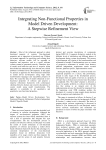
Integrating Non-Functional Properties in Model Driven Development: A Stepwise Refinement View
Статья научная
Most of the refinement approach is about functional property of systems. Non-functional properties are as important as functional one. Without an accurate approach for specifying and refining their behaviors, software models will be regarded as imperfect and imprecise, and as a result, software systems cannot be generated correctly. Therefore, how to model such behaviors and how to stepwise refine these behaviors automatically, have become two critical problems in Model Driven Development. In this paper we present an approach for Non-functional refinement in model driven development using high order transformation languages and traceability property of them. We extend the idea of model refinement to non-functional properties of software and propose a stepwise refinement framework with conformance checking between abstract and concrete descriptions of system model using model transformation. The approach is extendable to all quantitative and quantitative non-functional properties.
Бесплатно
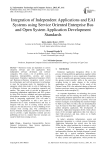
Статья научная
Businesses today are dependent on custom enterprise software and web applications from independent software developers and software companies. This creates a lot of problems such as integration, interoperability, security, and system maintenance. Enterprise Application Integration (EAI) and Business-to-Business integration control several key technologies and swift advancement in technology to meet the increasing needs for integration in the enterprise which often results in a lot of challenges due to differences between one proprietary approach and another. This paper seeks to provide an approach of integrating independent applications and EAI systems by using Web services standards and open application development standards in dealing with the challenges faced in integrating applications. This will make it possible for organizations to add a new layer of abstraction that is open, standards-based, and easy to integrate with any new or existing system and also make easy for data discovery as well as building of new concepts from existing data. The combination of Service Oriented Architecture and Web services will be used to provide a rapid integration solution and also publishing services in a manner that new concepts can easily be built from existing services.
Бесплатно
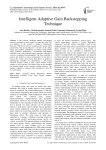
Intelligent Adaptive Gain Backstepping Technique
Статья научная
In this research, intelligent adaptive backstepping control is presented as robust control for continuum robot. The first objective in this research is design a Proportional-Derivative (PD) fuzzy system to compensate the system model uncertainties. The second objective is focused on the design tuning gain adaptive methodology according to high quality partly nonlinear methodology. Conventional backstepping controller is one of the important robust controllers especially to control of continuum robot manipulator. The fuzzy controller is used in this method to system compensation. In real time to increase the system robust fuzzy logic theory is applied to backstepping controller. To approximate a time-varying nonlinear dynamic system, a fuzzy system requires a large amount of fuzzy rule base. The adaptive laws in this algorithm are designed based on the Lyapunov stability theorem. This method is applied to continuum robot manipulator to have the best performance.
Бесплатно
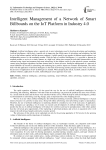
Intelligent Management of a Network of Smart Billboards on the IoT Platform in Industry 4.0
Статья научная
Artificial intelligence plays a special role in new technologies used to develop advertising and marketing. Artificial intelligence, which plays a special role in improving the effectiveness of advertising and marketing, has had its say in the business market, and this process continues. A quick search for any product in Internet search engines is an indispensable process for the marketing market. With the help of artificial intelligence, it is possible to present the required product or service in a timely manner, at a high level, taking into account the individual characteristics of the customer using virtual environments and street advertising. In the modern world of cyber-physical systems, machines created using intelligent algorithms facilitate human labor in almost all areas. Intelligent management of a network of smart billboards AI research in advertising and marketing has a positive impact on economic development. The article deals with the application of artificial intelligence in the field of advertising and the principle of their work. In this area, the processes of application of new technologies are studied. When preparing the article, scientific analysis of problems and their solutions, application of results, methodological system approach were used.
Бесплатно
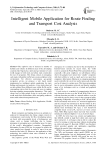
Intelligent Mobile Application for Route Finding and Transport Cost Analysis
Статья научная
The explosive rate of increase in number of habitats and vehicles in different areas of the developing countries like Nigeria has motivated government of such world engage in both rural and urban road construction for ease of navigation. This brings stresses in navigating such roads with public traffic hence noise pollution to the environment. For effective autonomous geo-spatial navigation service, we propose a web based model implemented as intelligent mobile application for route finding and transport cost analysis. A case study observed on data collated from different areas within Ile-Ife and its surroundings shows that the system aid users in making decision regarding transportation alternatives. This study shows how to help people living in such parts of the world reach their destinations when navigating unknown routes with reduced transportation cost.
Бесплатно

Intelligent Vision Methodology for Detection of the Cutting Tool Breakage
Статья научная
In this paper, a new Intelligent system based on neurofuzzy for detecting and diagnostics the wear and damage of the milling cutter is presented. The compatibility between the computer vision and neurofuzzy techniques is introduced. The proposed approaches consists of capturing the milling cutter image, Fuzzy edge detection, Chain code technique for feature extraction and finally, apply the neural network on the feature. The results of the study are three different diagnostics models, The first is diagnostic model for the original profile of the perfect cutter, the second is model for the wearied profile and the third is model for the damage profile. Experimental test results show that the proposed system is reliable, practical and can be used for the easy distinguish between the wear and damage automatically.
Бесплатно

